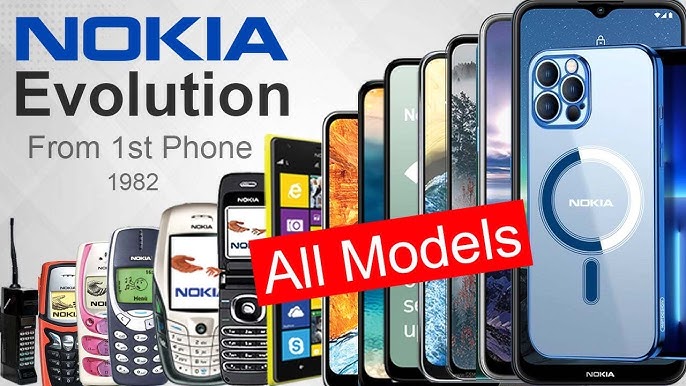Nokia Mobile:- When it comes to the history of mobile phones, Nokia stands out as one of the most iconic and influential brands in the world. From dominating the global mobile market in the early 2000s to facing challenges from smartphone competitors, Nokia’s journey is a fascinating story of innovation, adaptability, and resilience.
This article explores the origin of Nokia, its rise to the top, the decline, and the modern revival of its mobile business.

1. Origins of Nokia: The Early Days (1865–1980s)
Nokia’s story begins far before the invention of the mobile phone. In 1865, Finnish engineer Fredrik Idestam founded a pulp mill in Tampere, Finland. The company was named Nokia after the Nokianvirta River near its second mill.
Over the decades, Nokia expanded into different industries, including rubber, cables, and electronics. By the late 20th century, Nokia had evolved into a diversified conglomerate, laying the foundation for its entry into the telecommunications industry.
2. Entering the Mobile Phone Market (1980s–1990s)
Nokia entered the mobile phone market in the 1980s, producing some of the earliest car phones and portable models. In 1987, Nokia released the Mobira Cityman, one of the first handheld mobile phones, famously used by Mikhail Gorbachev.
By the early 1990s, Nokia focused heavily on telecommunications and mobile technology, selling off non-core businesses like tires and consumer electronics. This strategic shift allowed Nokia to invest in research and development for digital GSM technology, which became the global mobile communication standard.
3. The Golden Era of Nokia (1998–2007)
Between the late 1990s and early 2000s, Nokia became a global mobile phone leader.
Some key milestones from this era:
- 1998 – Nokia became the world’s largest mobile phone manufacturer.
- 1999 – The release of the Nokia 3210, a phone famous for its long battery life, customizable covers, and the legendary Snake game.
- 2000–2005 – Models like the Nokia 3310, Nokia 6600, and Nokia N-Series became bestsellers worldwide.
- Nokia phones were known for:
- Exceptional durability
- Long battery life
- User-friendly interface
- Reliable SMS and call quality
During this period, Nokia’s Symbian OS dominated the mobile phone software market, holding over 40% global market share.

4. The Decline: Missing the Smartphone Revolution (2007–2013)
In 2007, Apple introduced the iPhone, and in 2008, Google launched Android. These events marked the start of the smartphone era.
Nokia, however, continued focusing on feature phones and its Symbian platform, underestimating the rapid shift towards touchscreens and app-based ecosystems. This miscalculation cost Nokia dearly.
Key reasons for the decline:
- Late adoption of Android
- Over-reliance on Symbian OS
- Stiff competition from Apple, Samsung, and Chinese brands
- Poor reception of some smartphone models
By 2011, Nokia partnered with Microsoft to produce Windows Phone devices, but sales could not match Android and iOS rivals.
5. Microsoft Acquisition and Exit from Mobile (2014–2016)
In 2014, Microsoft acquired Nokia’s mobile phone business for around $7.2 billion. Nokia-branded Lumia smartphones ran on the Windows Phone OS, but the platform struggled to attract developers and users.
By 2016, Microsoft wrote off the acquisition, sold the Nokia brand licensing rights, and effectively exited the mobile phone market.
6. The Revival: HMD Global and Nokia’s Return (2016–Present)
In 2016, Finnish company HMD Global acquired rights to use the Nokia brand for mobile devices. Nokia made a strong comeback by:
- Launching Android-powered smartphones
- Reviving classic models like the Nokia 3310 (2017 edition)
- Offering budget-friendly, mid-range, and durable phones with clean Android experiences
Today, Nokia focuses on:
- 5G smartphones
- Feature phones for emerging markets
- Eco-friendly and sustainable designs
The brand leverages its legacy of trust, durability, and simplicity while adapting to modern smartphone demands.

7. Notable Nokia Mobil Models Through History
- Mobira Cityman (1987) – One of the first handheld mobile phones
- Nokia 1011 (1992) – First GSM phone
- Nokia 3310 (2000) – Iconic durability and long battery life
- Nokia N95 (2007) – Flagship Symbian smartphone with advanced camera features
- Nokia Lumia 1020 (2013) – Windows Phone with a 41MP camera
- Nokia 8.3 5G (2020) – Modern 5G Android smartphone
8. The Legacy of Nokia in Mobile History
Nokia’s journey is a story of innovation, dominance, decline, and rebirth. While it lost its crown in the smartphone race, Nokia remains one of the most trusted mobile brands in the world.
Its legacy lives on through:
- Classic durable designs
- Iconic ringtone & Snake game
- Pioneering GSM technology
- Commitment to connecting people
As of 2025, Nokia continues to serve both modern smartphone users and feature phone enthusiasts, proving that a brand can reinvent itself and survive even after major setbacks.
✅ Conclusion – Nokia Mobile
The history of Nokia Mobile is more than a corporate timeline—it’s a reflection of how technology, consumer preferences, and global markets evolve. Nokia may no longer be the dominant giant it once was, but its name still resonates with reliability, nostalgia, and innovation.


 Watch
Watch
 CASUAL WEAR
CASUAL WEAR


[…] days, or even weeks to reach their destination. Letters traveled by horse, steamship, or train. Telecommunication was limited to smoke signals, semaphore, or the electric telegraph—a system that could send dots […]